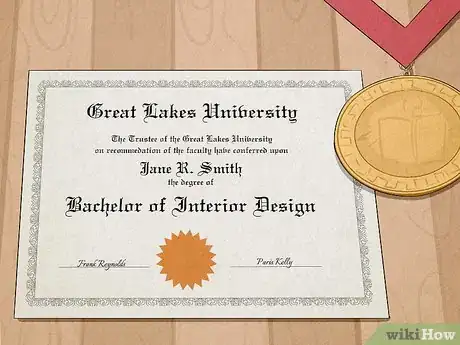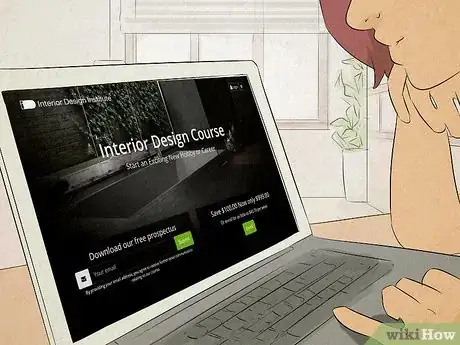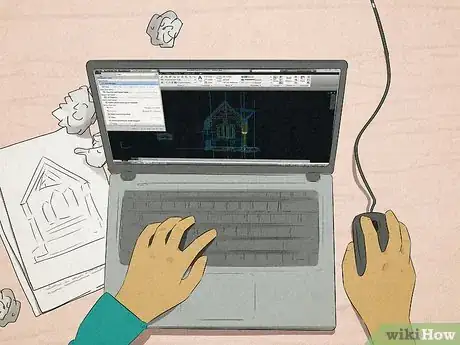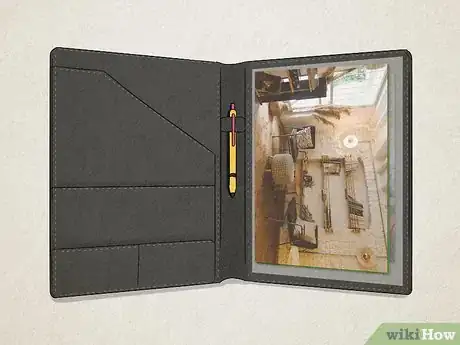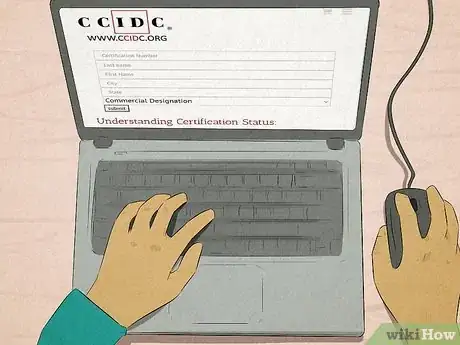This article was co-authored by MacKenzie Cain and by wikiHow staff writer, Kyle Hall. MacKenzie Cain is an Interior Designer and a LEED-certified Green Associate for Habitar Design based in Chicago, Illinois. She has over seven years of experience in interior design and architectural design. She received a BA in Interior Design from Purdue University in 2013 and received her LEED Green Associate certification from the Green Building Certification Institute in 2013.
There are 19 references cited in this article, which can be found at the bottom of the page.
This article has been viewed 20,374 times.
Interior design is an exciting profession where you can combine your creative and technical sides. Because many states and provinces in the U.S. and Canada require certification for you to register as a “certified interior designer,” it’s important to know where to find the right knowledge when you’re getting started.[1] X Research source We’ve compiled some of the best ways to kickstart your design journey or improve your interior design skills![2] X Research source
Steps
Choose interior design if you’d like a technical background or interior decoration to launch your career sooner.
-
Interior design combines aesthetic and practical elements. People commonly confuse interior decorators with interior designers, but their roles and career paths are different. Interior decorators make stylistic choices like furnishings and textiles to decorate spaces that are already built. Interior designers can decorate, too, but they may also play a role in making the space itself.[3] X Trustworthy Source US Bureau of Labor Statistics U.S. government agency that collects and reports labor-related information Go to source
- Interior designers must understand technical aspects of construction like build-site analysis and building systems standards.[4] X Research source
- Designers require formal education and certification, and in some states, they require an additional license.
- To pursue a career in interior design, plan for 4 years of education and 2 years of work experience before certification.
- Interior decorators do not require formal education or certification to begin working.
Pursue a B.A. in interior design or architecture.
-
Formal education is a common first step in learning about interior design. The Council for Interior Design Accreditation (CIDA) offers accreditation for bachelor’s and master’s degree programs, which shows the program meets professional standards.[5] X Trustworthy Source US Bureau of Labor Statistics U.S. government agency that collects and reports labor-related information Go to source However, your degree program doesn’t have to be accredited for you to be eligible to take a certification exam. And besides accreditation, there are a few important things to keep in mind when choosing a program.[6] X Research source
- Consider the program’s length, whether it’s online or in-person, the tuition cost, and the university’s location and size.
- Evaluate the program’s rankings, admission rate, and alumni network.
- Set up an appointment with a faculty member, admissions officer, or current student if you need more information to decide if the program is right for you.
- Ask about what classes are offered, the program’s specific niche or teaching philosophy, and the types of jobs students get after graduation.
- Be sure to study construction—to be a good designer, it's important to understand what can be built and what is impractical.[7]
X
Expert Source

Interior Designer & LEED Green Associate Expert Interview. 7 April 2020.
Take an online course to substitute for a B.A. or to add specific software or industry skills.
-
Many reputable design schools offer online courses. Look for continuing education or university extension courses that offer certificates or diplomas. As with professional degree programs, check the accreditation and rankings of the course.
- If you already have a degree unrelated to interior design, online courses that offer certificates or diplomas can give you the qualification you need to sit for certification exams.[8] X Research source
- You can also take online courses to learn new software or to step into a new specialty like industrial or healthcare design.
Practice with design software.
-
Software is an essential part of modern interior design. With the right tools, you can create and showcase your best work.[9] X Research source
- From free online tutorials to paid courses, there are lots of options for learning Computer-Aided Design (CAD) software like AutoCAD LT, SketchUp Pro, and Arcticid 23.
- Photography tools like Adobe Photoshop and Adobe Capture are also great industry-standard tools to learn for manipulating images.
- To take your software skills to the next level, learn how to use client management programs created for design firms. Programs like Fugit, Ivy, and Co-Construct assist with sourcing, purchasing, client and contractor communication, and more.
Build your knowledge of material sourcing.
-
Good design requires practical knowledge. Plus, understanding the best uses of materials and sourcing for furniture, fixtures, and equipment (FF&E) can give you an edge as a newer designer. Consider the project’s budget and design requirements first when you’re sourcing materials. For example, will a certain carpet need to be ultra-durable for a busy hallway? You’ll need to balance the aesthetics of materials with their practical properties like flammability, durability, sustainability, and even legal codes.[10] X Research source
- An example of a material-sourcing decision: You need to choose between plywood and milled lumber for cabinets. Thanks to your sourcing knowledge, you know milled lumber is more durable, but your project has a small budget, so you choose plywood for affordability.[11] X Research source
- Look through design firm libraries, trade magazines, trade fairs, trade associations, and online databases to learn more about specific materials.[12] X Research source
- You can also talk to manufacturers and sales representatives to learn more about their products and how they meet standards.
- Bolster your sourcing knowledge with information on cost-estimating methods. Common methods are square footage assessments (based on the cost of materials for a given area), itemized budgets (based on estimations for specific material costs), and quantity takeoffs (based on both estimated material and labor costs).
Keep an eye on trends.
-
Society, technology, and pop culture affect the design industry’s direction. By keeping an eye on trends within the industry and staying up-to-date on cultural fads, you can create more current designs. For instance, with the prevalence of technology, designers are thinking more about how to make spaces appealing when visitors snap photos for social media.[13] X Research source
- Even as you experiment with different trends, remember to keep growing your cohesive style.[14] X Research source
- Browse design blogs, books, websites, and social media to keep up with industry trends.[15]
X
Expert Source

Interior Designer & LEED Green Associate Expert Interview. 7 April 2020. [16] X Research source
Build a portfolio.
-
A portfolio shows off your experience and unique style. While it’s ideal to showcase a diverse number of real projects you’ve worked on, there are plenty of options to expand your portfolio with less experience. You’ll ideally aim for 8-10 examples of full projects (but 4-5 is fine if you’re starting). Include a mix of color schemes, mood boards, CAD sketches, interior photos, and more detailed interior shots of styling.[17] X Research source
- Be innovative. Your portfolio doesn’t have budget or project timeline constraints, so you can show off your style through designs that represent what you’d like to do.
- If you don’t have real projects from work experience, imagine you’re working on a specific project. Create mood boards, color schemes, floorplans, and 3-D renderings that show your capabilities.
- Briefly tell the story of each real project in your portfolio. What did the client ask for? What were the key choices you made?
- Include quantitative results in your portfolio. If your cafe remodels helped increase the number of dine-in customers by 10%, or if the materials you chose cut carbon emissions by half, those are good metrics to highlight your capabilities.
Ask trade specialists to review your designs.
-
It’s important that your work is practical and meets regulations. An interior designer’s role overlaps with architects, civil engineers, electricians, and more, so it’s important to get those specialized elements correct. By having experts review your work, you can fix errors and learn what’s correct for future projects.[18] X Research source
- Before you submit your portfolio for a job application, ask a plumber, electrician, and carpenter to review it to ensure your designs are practical and up to code.
- As you gain work experience, ask for input from more experienced designers to keep learning.
Choose a specific industry, design style, or thematic focus for your career.
-
Passion for a specific area of design can set you apart as you start to apply for jobs. Do you want to be a kitchen designer, corporate designer, healthcare designer, or something else? Whether you want to pursue a broader focus like sustainability or work in a specific industry like the hotel or restaurant business, you can find a niche.[19] X Research source
- Identify the type of interior you’d best like to design. For instance, you can go large scale and design shopping malls as a corporate designer. Or you can go small-scale, designing houses, lofts, and cabins as a residential designer.
- Is there a particular style you’re drawn to? Having a sense of whether you’d like to do avant-garde, minimalist, or modern design (as just three of the many options!) can help guide you.
- Consider what types of clients you want to work with. For example, would you prefer to work with homeowners, corporations, or local governments?
Obtain work experience.
-
Professional experience helps you hone your skills. To get a head start, look for an internship while you’re still getting your degree. Find an entry-level position by reviewing online job boards, networking with alumni, and visiting your school’s career center. Schedule informational interviews with people you know in your field to ask about their career paths. You can learn about the day-to-day life of an interior designer while working towards the 3,520 hours (or 2 years full time) required for certification through the most common certification exam, the National Council for Interior Design Qualification (NCIDQ).[20] X Research source
- Design firms are more likely to hire new designers for styling contracts rather than architectural contracts.[21] X Research source
- Use social media to keep up your network and maintain connections with people you meet in the industry.
- While you’re sharpening your creative skills, use your internship or junior role to also learn about the business/client side of interior design.[22] X Research source
- When you’re looking for employers, aim for licensed interior designers or architects who focus on interior design.[23] X Research source
Take the NCIDQ or CCIDC exam to get certified.
-
Certification gives you credibility and in some places is required by law. If you’re in the U.S. or Canada, study for and pass the three-part National Council for Interior Design Qualification exam (NCIDQ). Across the three parts, you’ll demonstrate your knowledge of design fundamentals, professional practices, and you’ll complete a practicum, which includes case studies on a small commercial, large commercial, and multi-family residential project. To be eligible to take the full NCIDQ exam, demonstrate formal training through a B.A. in interior design or certificate program, and gain 3,520 hours (or 2 years full-time) of work experience under a licensed interior designer or architect.[24] X Research source
- If you’re in your final year of a B.A. and don’t have work experience, apply to take just the Interior Design Fundamentals Exam (IDFX) and then take the other two exam parts (Interior Design Professional Exam and Practicum) after you complete your required work hours.[25] X Research source .
- Score above 500 on all parts of the test to pass. A score of 200 designates zero correct answers and a score of 800 means all answers are correct.[26] X Research source
- If you’re in California, take the IDEX by the California Council for Interior Design Certification (CCIDC) instead of the NCIDQ to get certified.[27] X Research source
Register with your state as an interior designer.
-
You may need an additional state license to practice as an interior designer. For most states, passing the NCIDQ is considered sufficient certification. [28] X Trustworthy Source US Bureau of Labor Statistics U.S. government agency that collects and reports labor-related information Go to source However, if you live in a state that requires additional registration, apply for a license through the board or department that oversees professional regulation.[29] X Research source
- Nevada, Louisiana, the District of Columbia, and Puerto Rico require mandatory registration to practice as an interior designer.[30] X Research source
- Gather the required materials including transcripts, a completed work experience section, NCIDQ verification, and application fee.
- There are no federal licensing requirements, so be sure to check what you need for your state.[31] X Research source
You Might Also Like
 How to Hide a Modem and Router
How to Hide a Modem and Router





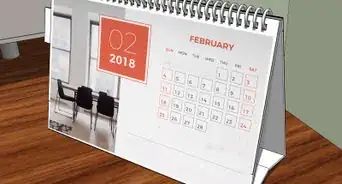







References
- ↑ https://www.architecturaldigest.com/story/am-i-a-real-designer-if-im-not-licensed
- ↑ https://www.cidq.org/why-ncidq-certification-matters
- ↑ https://www.bls.gov/ooh/arts-and-design/interior-designers.htm#tab-2
- ↑ https://www.cidq.org/exams
- ↑ https://www.bls.gov/ooh/arts-and-design/interior-designers.htm#tab-4
- ↑ https://www.asid.org/belong/become
- ↑ MacKenzie Cain. Interior Designer & LEED Green Associate. Expert Interview. 7 April 2020.
- ↑ https://www.cidq.org/paths
- ↑ https://www.architecturaldigest.com/story/best-interior-design-software-programs
- ↑ https://www.arts.ac.uk/study-at-ual/short-courses/stories/how-to-become-an-interior-designer
- ↑ https://www.woodmagazine.com/materials-guide/lumber/what-you-need-to-know-about-plywood
- ↑ https://healthymaterialslab.org/tool-guides
- ↑ https://www.arts.ac.uk/study-at-ual/short-courses/stories/how-to-become-an-interior-designer
- ↑ https://blog.academyart.edu/keeping-up-with-design-trends-top-best-practices/
- ↑ MacKenzie Cain. Interior Designer & LEED Green Associate. Expert Interview. 7 April 2020.
- ↑ https://www.graphicdesigndegreehub.com/faq/how-does-a-graphic-designer-keep-up-with-design-trends/
- ↑ https://www.aiga.org/4-easy-steps-to-create-a-beautiful-design-portfolio
- ↑ https://www.arts.ac.uk/study-at-ual/short-courses/stories/how-to-become-an-interior-designer
- ↑ https://www.usnews.com/education/learn-interior-designer-guide
- ↑ https://www.cidq.org/paths
- ↑ https://www.arts.ac.uk/study-at-ual/short-courses/stories/how-to-become-an-interior-designer
- ↑ https://www.arts.ac.uk/study-at-ual/short-courses/stories/how-to-become-an-interior-designer
- ↑ https://www.cidq.org/paths
- ↑ https://www.cidq.org/paths
- ↑ https://www.cidq.org/schedule-exams
- ↑ https://www.cidq.org/scoring-process
- ↑ https://ccidc.org/becoming-a-certified-interior-designer/
- ↑ https://www.bls.gov/ooh/arts-and-design/interior-designers.htm#tab-4
- ↑ https://www.cidq.org/paths
- ↑ https://www.architecturaldigest.com/story/am-i-a-real-designer-if-im-not-licensed
- ↑ https://www.architecturaldigest.com/story/am-i-a-real-designer-if-im-not-licensed
About This Article


